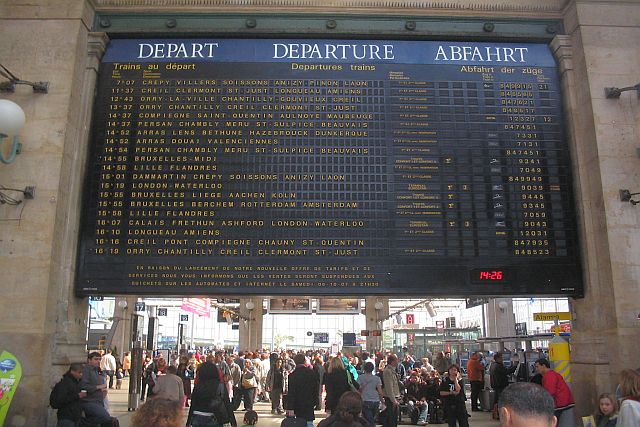 |
| Eurostar train exits the Channel Tunnel connecting London to Paris in about three hours (Courtesy: Rail Europe) |
EUROPE — As flying becomes an increasingly tedious means of
travel and driving gets more and more expensive, savvy American travelers are
rapidly waking up to the idea of using trains as their primary mode of
transportation in Europe.
Rail Europe is easily the best one-stop shop for information
about rail passes and just about anything else you will need to stay on track
while traveling by rail on the continent.
 |
| Germany's sleek ICE (Courtesy: Rail Europe) |
So what
are the big advantages of using trains over some of our more traditional American
methods of movement?
·
Frequency
of service
·
Comfort
·
Speed
(most trips of 3 1/2 hours or less are faster by rail)
·
Arrivals
and departures are usually city-center to city-center
·
Food
services on board
·
Wi-Fi
access
Most of Europe 's larger countries continue to expand high speed
rail services with trains that typically speed through the countryside at
186-miles per hour. France , Germany and Italy
 |
| TGV in the French Riviera (Courtesy: Rail Europe) |
Some
countries such as Italy
If there
is a drawback for inexperienced travelers, it may be the seemingly overwhelming
number of rail passchoices since each country has individual services which
suit their specific needs. That can also translate to confusion about which
rail pass is best for your purposes or if individual point-to-point tickets are
a better option.
 |
| Trains operate throughout the day with plenty of service to every corner of Europe (Courtesy: Rail Europe) |
Today
the Eurail network encompasses 31 countries, which can be intimidating for someone
to navigate through the myriad of passes to locate the proper ticket at the
best price?
For
starters, Rail Europe's prices run from calendar year to calendar year...the
price of a pass on January 1 will be the
same until December 31.
 |
| Rail passes are user friendly (Courtesy: Rail Europe) |
Next,
and this is the single most important thing to know about rail passes, there
really are ONLY two main types of pass; Consecutive Days and Flexipasses.
A Consecutive Day Pass
 |
| Panoramic train in Switzerland (Courtesy: Rail Europe) |
A
Flexipass, on the other hand, allows riders to select when they want to travel
during a given period of time. If you purchase three days of travel during a 15
day period, you can then choose which three days you will travel during the
time period of two weeks plus one day.
That's
it! EVERY rail pass is a combination of one of those types.
From
that point on you can purchase single country passes, combination passes,
multiple country passes and so on. Therefore, if you will only be traveling in Switzerland , why buy a pass that also includes France and Germany
 |
| Some trains, like the Cisalpino, tilt for extra speed (Courtesy: Rail Europe) |
Just
keep in mind that, generally, the more countries you add and the more days you
buy will determine the final price.
With
that said many passes have some excellent discounts. Be sure to check for
senior or children's discounts.
 |
| Saverpasses offer discounts for 2 to 5 people traveling together (Courtesy: Rail Europe) |
A
Saverpass is another way to reduce the fare. Two to five people traveling
together qualify as a group as long as they travel with each other.
Some
people try to save money by going second class rather than first. Let's face
it, if you're going to spend the money to go all the way to Europe ,
this is not the place to cut corners.
 |
| First Class interior of a Thalys, often called "Big Red" (Courtesy: Rail Europe) |
The main
difference between first and second class is comfort. Seating configurations in
first class means fewer seats and more space, and there are fewer people in the
compartment so travel is quieter and less crowded.
Again,
each country has its own way of doing things so services will vary. In fact,
the time of day you travel can also determine which services are offered on
similar types of trains within a single country.
Some
trains offer meals served at your seat and complimentary drinks, adding to the
advantages of first class, and even before departing some stations there’s
priority check-in and access to lounges.
 |
| Train Bleu Restaurant in Gare du Nord in Paris hearkens to a Golden Age of travel (Courtesy: Rail Europe) |
It's
important to note that some high speed trains like the French TGVs do require
reservations which have an additional small fee. It is always best to check in
advance.
Timetables
are released six months in advance, and reservations can generally be made
three to six months before the travel dates. Savings of up to 80 per cent are
not unusual when booking early fares.
 |
| With a Swiss Travel Pass you can visit the Castle of Chillon for free (Courtesy: MySwitzerland.com) |
One of
the most overlooked aspects of traveling with a rail pass is the bonuses. Some passes
can just about pay for themselves by taking advantage of free or reduced fares
that come with pass. In Switzerland ,
for example, a Swiss
Travel Pass



























